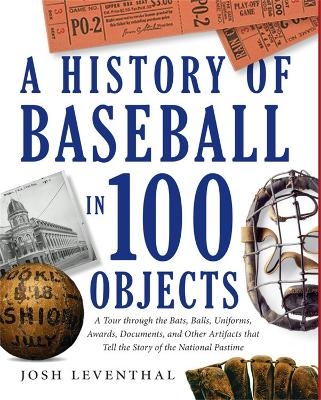
A History Of Baseball In 100 Objects
Seiten
2015
Black Dog & Leventhal Publishers Inc (Verlag)
978-1-57912-991-0 (ISBN)
Black Dog & Leventhal Publishers Inc (Verlag)
978-1-57912-991-0 (ISBN)
The only book of its kind to tell the history of baseball, from its inception to the present day, through 100 key objects that represent the major milestones, evolutionary events, and larger-than-life personalities that make up the game.
The only book of its kind to tell the history of baseball, from its inception to the present day, through 100 key objects that represent the major milestones, evolutionary events, and larger-than-life personalities that make up the game A History of Baseball in 100 Objects is a visual and historical record of the game as told through essential documents, letters, photographs, equipment, memorabilia, food and drink, merchandise and media items, and relics of popular culture, each of which represents the history and evolution of the game. Among these objects are the original ordinance banning baseball in Pittsfield, Massachusetts, in 1791 (the earliest known reference to the game in America); the 'By-laws and Rules of the Knickerbocker Base Ball Club,' 1845 (the first codified rules of the game); Fred Thayer's catcher's mask from the 1870s (the first use of this equipment in the game); a scorecard from the 1903 World Series (the first World Series); Grantland Rice's typewriter (the role of sportswriters in making baseball the national pastime); Babe Ruth's bat, circa 1927 (the emergence of the long ball); Pittsburgh Crawford's team bus, 1935 (the Negro Leagues); Jackie Robinson's Montreal Royals uniform, 1946 (the breaking of the color barrier); a ticket stub from the 1951 Giants-Dodgers playoff game and Bobby Thomson's 'Shot Heard 'Round The World' (one of baseball's iconic moments); Sandy Koufax's Cy Young Award, 1963 (the era of dominant pitchers); a 'Reggie!' candy bar, 1978 (the modern player as media star); Rickey Henderson's shoes, 1982 (baseball's all-time-greatest base stealer); the original architect's drawing for Oriole Park at Camden Yards (the ballpark renaissance of the 1990s); and Barry Bond's record-breaking bat (the age of Performance Enhancing Drugs). A full-page photograph of the object is accompanied by lively text that describes the historical significance of the object and its connection to baseball's history, as well as additional stories and information about that particular period in the history of the game.
The only book of its kind to tell the history of baseball, from its inception to the present day, through 100 key objects that represent the major milestones, evolutionary events, and larger-than-life personalities that make up the game A History of Baseball in 100 Objects is a visual and historical record of the game as told through essential documents, letters, photographs, equipment, memorabilia, food and drink, merchandise and media items, and relics of popular culture, each of which represents the history and evolution of the game. Among these objects are the original ordinance banning baseball in Pittsfield, Massachusetts, in 1791 (the earliest known reference to the game in America); the 'By-laws and Rules of the Knickerbocker Base Ball Club,' 1845 (the first codified rules of the game); Fred Thayer's catcher's mask from the 1870s (the first use of this equipment in the game); a scorecard from the 1903 World Series (the first World Series); Grantland Rice's typewriter (the role of sportswriters in making baseball the national pastime); Babe Ruth's bat, circa 1927 (the emergence of the long ball); Pittsburgh Crawford's team bus, 1935 (the Negro Leagues); Jackie Robinson's Montreal Royals uniform, 1946 (the breaking of the color barrier); a ticket stub from the 1951 Giants-Dodgers playoff game and Bobby Thomson's 'Shot Heard 'Round The World' (one of baseball's iconic moments); Sandy Koufax's Cy Young Award, 1963 (the era of dominant pitchers); a 'Reggie!' candy bar, 1978 (the modern player as media star); Rickey Henderson's shoes, 1982 (baseball's all-time-greatest base stealer); the original architect's drawing for Oriole Park at Camden Yards (the ballpark renaissance of the 1990s); and Barry Bond's record-breaking bat (the age of Performance Enhancing Drugs). A full-page photograph of the object is accompanied by lively text that describes the historical significance of the object and its connection to baseball's history, as well as additional stories and information about that particular period in the history of the game.
Josh Leventhal is an editor and the author of the best-selling book Take Me Out to the Ballpark, The World Series: An Illustrated History of the Fall Classic, and Baseball Yesterday & Today, among others. He lives in Minneapolis, Minnesota.
| Erscheint lt. Verlag | 5.5.2015 |
|---|---|
| Zusatzinfo | 125 colour & b&w photos |
| Verlagsort | New York |
| Sprache | englisch |
| Maße | 234 x 191 mm |
| Gewicht | 1582 g |
| Themenwelt | Sachbuch/Ratgeber ► Sport ► Ballsport |
| Geisteswissenschaften ► Geschichte ► Regional- / Ländergeschichte | |
| Geschichte ► Teilgebiete der Geschichte ► Kulturgeschichte | |
| Weitere Fachgebiete ► Sportwissenschaft | |
| ISBN-10 | 1-57912-991-9 / 1579129919 |
| ISBN-13 | 978-1-57912-991-0 / 9781579129910 |
| Zustand | Neuware |
| Haben Sie eine Frage zum Produkt? |
Mehr entdecken
aus dem Bereich
aus dem Bereich
der stille Abschied vom bäuerlichen Leben in Deutschland
Buch | Hardcover (2023)
C.H.Beck (Verlag)
CHF 32,15
vom Mittelalter bis zur Gegenwart
Buch | Softcover (2024)
C.H.Beck (Verlag)
CHF 16,80


